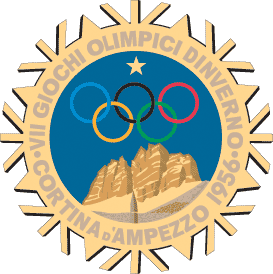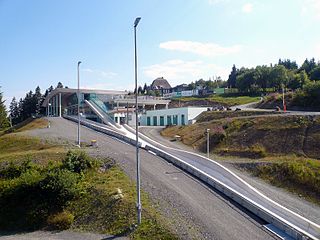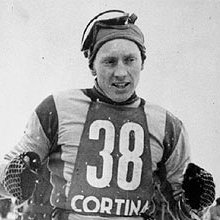
Eugenio Monti was an Italian bobsledder. He is one of the most successful athletes in the history of this sport, with ten World championship medals and 6 Olympic medals including two golds. He is known also for his acts of sportsmanship during the 1964 Winter Olympics in Innsbruck, Austria, which made him the first athlete ever to receive the Pierre de Coubertin medal.
Victor Emery is a Canadian athlete and businessman. Emery was born in Montreal, Quebec. He is a gold medalist in the four man bobsleigh pilot from the 1964 Olympic Winter Games, as well as the 1965 World Championships.
The IBSF World Championships, part of the International Bobsleigh and Skeleton Federation, have taken place on an annual basis in non-Winter Olympic years since 1930. A two-man event was included in 1931 with a combined championship occurring in 1947. Men's skeleton was introduced as a championship of its own in 1982 while women's bobsleigh and skeleton events were introduced in 2000. Both the women's bobsleigh and skeleton events were merged with the men's bobsleigh events at the 2004 championships. A mixed team event, consisting of one run each of men's skeleton, women's skeleton, 2-man bobsleigh, and 2-women bobsleigh debuted in 2007.
The FIBT World Championships 1960 took place in Cortina d'Ampezzo, Italy for the fifth time. The Italian city had hosted the event previously in 1937 (Two-man), 1939 (Four-man), 1950, and 1954. This was an extraordinary event because bobsleigh was not included in the program at the 1960 Winter Olympics in Squaw Valley, California.
The FIBT World Championships 1981 took place in Cortina d'Ampezzo, Italy for the seventh time, having hosted the event previously in 1937 (Two-man), 1939 (Four-man), 1950, 1954, 1960, and 1966. Following the death of West Germany's Toni Pensperger at the track in 1966, numerous safety improvements were done at the track which were satisfactory enough for the FIBT to allow the championships to be hosted. These improvements would not be enough as American bobsledder James Morgan was killed during the four-man event. The death of a stuntman on the track during the first day of filming of For Your Eyes Only, done a week after these championships led track officials to shorten the track to its current configuration. Cortina would not host another championship until 1989.
The FIBT World Championships 1999 took place in Cortina d'Ampezzo, Italy (Bobsleigh) and Altenberg, Germany (Skeleton). Cortina hosted the championships for the ninth time, previously doing so in 1937 (Two-man), 1939 (Four-man), 1950, 1954, 1960, 1966, 1981, and 1989 (Bobsleigh). Altenberg hosted the championship event for the third time, doing so previously in 1991 (Bobsleigh) and 1994 (Skeleton).

Susi-Lisa Erdmann is an East German-German luger and bobsledder who competed from 1977 to 1998 in luge, then since 1999 in bobsleigh. Competing in five Winter Olympics, she won two medals in the women's singles luge event with a silver in 1994 and a bronze in 1992, and a bronze at the inaugural two-women bobsleigh event in 2002. She is one of only two people to ever win a medal in both bobsleigh and luge at the Winter Olympics; Italy's Gerda Weissensteiner is the other.
Reto Capadrutt was a Swiss bobsledder who competed in the 1930s. Competing in two Winter Olympics, he won a silver medal in the two-man event in 1932 and another silver medal in the four-man event in 1936.
Gianfranco Gaspari is an Italian bobsledder who competed from the late 1960s to the early 1970s. He won four medals at the FIBT World Championships with one gold, two silvers, and one bronze.
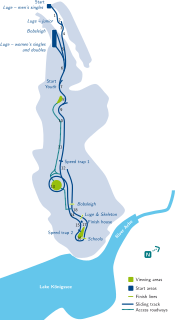
The Königssee bobsleigh, luge, and skeleton track is a venue for bobsleigh, luge and skeleton located in Schönau am Königsee, Germany. It is located near Königssee. Completed in 1968, it is the first permanent, artificially refrigerated bobsleigh, luge, and skeleton track in the world.
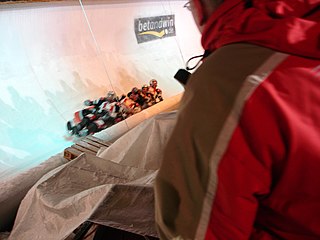
The Olympic Sliding Centre Innsbruck is a venue for bobsleigh, luge and skeleton located in Igls, Austria. The most recent version of the track was completed in 1975 and is the first permanent, combination artificially refrigerated bobsleigh, luge, and skeleton track, serving as a model for other tracks of its kind worldwide. It hosted the bobsleigh, luge, and skeleton competitions for the 2012 Winter Youth Olympics.
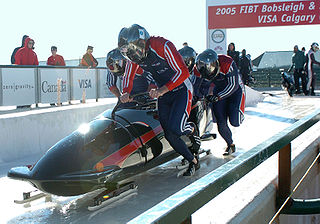
The Canada Olympic Park bobsleigh, luge, and skeleton track is a bobsleigh, luge, and skeleton track located in Calgary, Alberta. Part of Canada Olympic Park, it hosted the bobsleigh and luge competitions at the 1988 Winter Olympics. This track is one of only two of its type in the world to be featured in a non-documentary film when it was part of the 1993 American film Cool Runnings which loosely followed the Jamaican Bobsled Team during their competition in bobsleigh at the 1988 Games.
The La Plagne bobsleigh, luge, and skeleton track is a bobsleigh, luge, and skeleton track located in La Plagne, France. The track was the venue for the bobsleigh and luge competitions for the 1992 Winter Olympics whose host city was neighboring Albertville.
James Patrick Morgan, known as Jimmy, but nicknamed "Nitro" was an American bobsledder who competed from the mid-1970s to the early 1980s. His death during the 1981 FIBT World Championships in Cortina d'Ampezzo, Italy at the bobsleigh track used for the 1956 Winter Olympics coupled with the death of a stuntman involved in the production of the 1981 film For Your Eyes Only would lead to the shortening of the Cortina d'Ampezzo track to its current configuration.
The 2008–09 Bobsleigh World Cup was a multi race tournament over a season for bobsleigh. The season started on November 24, 2008 in Winterberg and ended on February 14, 2009 in Park City, Utah. The World Cup was organised by the FIBT who also run world cups and championships in skeleton.
For the 1956 Winter Olympics in Cortina d'Ampezzo, Italy, a total of eight sports venues were used. All of the venues used were new or rebuilt. To make use of television coverage for the first time in the Winter Olympics, the cross-country skiing stadium was constructed to allow the best coverage. Five of the venues used for these games would appear in the James Bond film For Your Eyes Only twenty-five years later.











